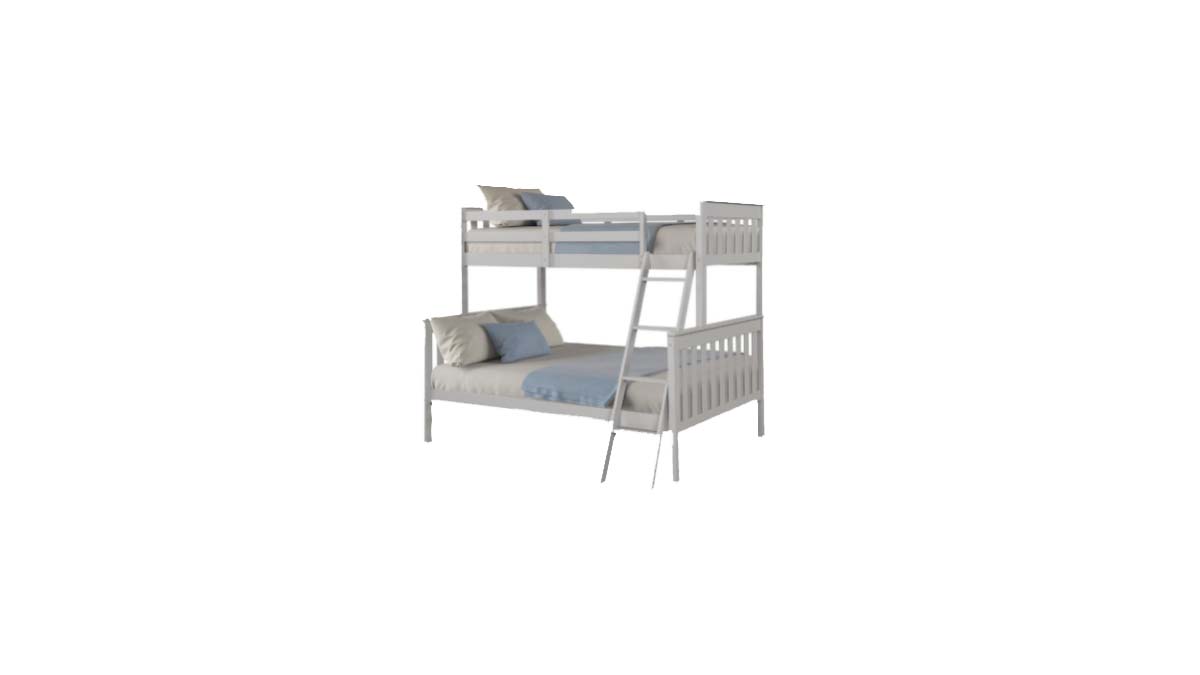In the shadow of multiple recalls involving infant sleepers that put babies at serious risk for death by asphyxiation, a recent recall of children’s bunk beds signifies that unsafe sleep products can be a problem even for older children.
On December 22, 2021, importer Longwood Forest Products issued a joint recall with the Consumer Product Safety Commission (CPSC) for nearly 40,000 bunk beds, stating that they pose an entrapment and strangulation hazard to children. According to the notice, a metal hook that fastens an angled ladder to the top bunk bed frame can move away or detach from the bed frame when the ladder is lifted and create a gap of more than 3.5 inches between the ladder step and bed frame. Children can become entrapped in that gap and strangle to death. A 2-year-old boy from Columbus, Ohio, died in May 2018 after he was found unresponsive in this gap.
Three models of Angel Line Bunk Beds are included in the recall: Fremont Twin over Twin Bunk Bed (model numbers 71210-21, 71210-49 and 71210-67); Creston Twin over Twin Bunk Bed (71230-21, 71230-49 and 71230-75); and Brandon Twin over Full Bunk Bed (71420-21 and 71420-75). The bunk beds were sold by online retailers Amazon, OJCommerce, Walmart and Wayfair from March 2016 through June 2021 for between $180 to $330.
The recall notice instructs consumers to immediately stop using the bunk beds, to block children’s access to them, and to contact Angel Line to receive a free repair kit with reinforcement brackets for the ladder. Consumers who paid for the bunk beds to be assembled when purchased will receive reimbursement for help with installing the repair kit if needed.
How Safe Are Bunk Beds?
Bunk bed injuries send an estimated 36,000 Americans ages 21 and younger to the emergency room each year, according to a 2008 study conducted by researchers at Nationwide Children’s Hospital. The study, which examined non-fatal bunk bed injuries treated in emergency departments across the U.S. from 1990 through 2005, found that lacerations, contusions/abrasions and fractures were the most common injuries. While these injuries, of course, can be severe, children have also died in what should have been the safety their own bed.
From January 1990 through August 9, 1999 there were 91 reported bunk bed-related deaths to children under 15 years of age, according to the CPSC. Of these deaths, 57 children became fatally entrapped, 25 children died when they inadvertently became hung from a bunk by such items as a belt or sash, a rope, clothing or bedding, and nine children died due to falls from bunk beds.
In 2000, the CPSC issued a federal safety standard to address concerns about falls and entrapments from bunk beds. The standard requires that openings in the upper bunk structure must be less than 3.5 inches, so that a child will not become entrapped, and also provides specifications to ensure that mattresses fit properly. The standard further requires that the upper bunk have guardrails on both sides and that the wall-side rail must be continuous. The importance of a wall-side rail made international headlines in 2011 when a 4-year-old boy from the United Kingdom hanged himself after becoming entrapped between a top bunk and the wall. His family had left off the wall-side rail when they assembled the top bunk, thinking that it would not be a problem because the bed was pushed against the wall. In the United States, a 2-year-old boy from Milwaukee, Wisconsin, died by suffocation in 2016, while in the care of a babysitter, when he climbed into the top bunk of his older brother’s bed and got stuck between the bed frame and the wall. Manufacturers are well aware of the fact that small children and toddlers often climb to the top bunk. While both of these boys were too young to be in the top bunk pursuant to the safety standard instituted in 2000 and warnings on the product stating that children under age 6 should not use the top bunk, their use of the top bunk was completely foreseeable.
Also, as the federal safety standard is not retroactive to older-model bunk beds, an untold number of unsafe beds may still be in use in people’s homes. These older-model bunk beds are governed by nothing more than a voluntary safety standard created primarily by the furniture industry itself, and compliance with this lax standard has been uneven. Between November 1994 and November 1999, there were nine recalls of approximately 536,000 bunk beds that did not conform to the entrapment requirements of the industry’s voluntary standard, according to the CPSC.
What Should I Do If My Child Is Injured in a Bunk Bed Accident?
Alan M. Feldman, a co-founding partner and product liability attorney at Feldman Shepherd, said that product liability law in most states requires that products be safe for their intended as well as expected use. He said that while he “is pleased that Longwood Forest has recalled its unsafe bunk beds, there is simply no excuse for a bed that, when used in a normal and expected manner, poses an entrapment and strangulation hazard to a child.” Feldman recommends contacting a product liability attorney in the event your child has been seriously injured in a bunk bed accident.
Feldman’s team at Feldman Shepherd, which includes partners Daniel J. Mann and Edward S. Goldis, has secured substantial recoveries on behalf of infants and young children who have been seriously injured or killed by children’s products, including unsafe furniture, baby slings and magnetic toys. In their unsafe furniture litigation practice, they recovered nearly $100 million on behalf of four families whose toddlers were fatally injured by unstable IKEA dressers, including a $46 million settlement in 2020 that is believed to be the largest child wrongful death recovery in American history.
